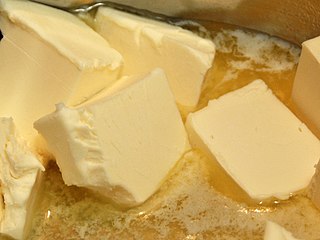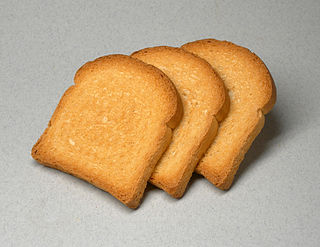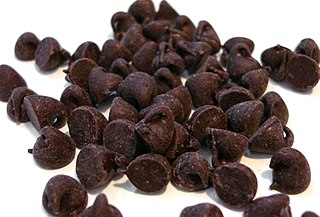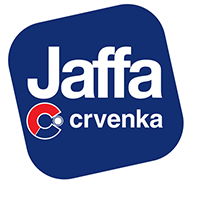

The Leibniz-Keks or Choco Leibniz is a German brand of biscuit or cookie produced by the Bahlsen food company since 1891. It was created by the firm as a rival to a similar French biscuit, the Petit-Beurre. [1]


The Leibniz-Keks or Choco Leibniz is a German brand of biscuit or cookie produced by the Bahlsen food company since 1891. It was created by the firm as a rival to a similar French biscuit, the Petit-Beurre. [1]
The brand name Leibniz comes from the philosopher and mathematician Gottfried Wilhelm Leibniz (1646–1716). The only connection between the man and the biscuit is that Leibniz was one of the more famous residents of Hanover, where the Bahlsen company is based. At the time when the biscuit was first made there was a fashion of naming food products after historical celebrities (such as Mozartkugeln). [2] [3]
The Leibniz-Keks is a plain butter biscuit, or Butterkeks as it is known in German, inspired by the French Petit-Beurre created in 1886 by Lefèvre-Utile. The word Keks in Leibniz-Keks was originally a corruption of the English word "cakes" by Bahlsen (who had originally called his product "cakes" but found out that this was mispronounced by the German public). Due to the popularity of the Leibniz-Keks, Keks has since become the generic German word for biscuit.[ citation needed ]
The original Leibniz biscuit has a simple and distinctive design. Fifty-two "teeth" frame the rectangular field on which "LEIBNIZ BUTTERKEKS" is imprinted in capital letters. This was Hermann Bahlsen's original 1891 design. There has been debate among biscuit fans whether it is in a square or rectangular shape. The main designer of the biscuits confirmed it is a square design. [ citation needed ]
The biscuit has been featured in a series of "Monuments of German Design" by the Süddeutsche Zeitung. [4]
In addition to the original Butterkeks, there are several varieties of Leibniz on the market today. These include Choco Leibniz (styled as "more chocolate than biscuit"), Leibniz Milch & Honig (milk and honey), Leibniz Vollkorn (wholemeal), and Leibniz Zoo (animal shapes).
Ingredients include sugar, wheatflour, Butter, in Choco Leibnitz cocoa mass, cocoa butter, whey products, glucose syrup, emulsifier, soya lecithin, whole milk powder, salt, raising agents, sodium bicarbonate, citric acid, and flavouring.[ citation needed ]

A cookie or biscuit is a baked snack or dessert that is typically small, flat, and sweet. It usually contains flour, sugar, egg, and some type of oil, fat, or butter. It may include other ingredients such as raisins, oats, chocolate chips, or nuts.

Butter is a dairy product made from the fat and protein components of churned cream. It is a semi-solid emulsion at room temperature, consisting of approximately 80% butterfat. It is used at room temperature as a spread, melted as a condiment, and used as a fat in baking, sauce-making, pan frying, and other cooking procedures.

A rusk is a hard, dry biscuit or a twice-baked bread. It is sometimes used as a teether for babies. In some cultures, rusk is made of cake, rather than bread: this is sometimes referred to as cake rusk. In the UK, the name also refers to a wheat-based food additive.

Ritter Sport is a brand of chocolate bar from the family-owned Alfred Ritter GmbH & Co. KG, which has its headquarters in Waldenbuch, Germany.

Milka is a Swiss brand of chocolate confectionery. Originally made in Switzerland in 1901 by Suchard, it has been produced in Lörrach, Germany, from 1901. Since 2012 it has been owned by US-based company Mondelez International, when it started following the steps of its predecessor Kraft Foods Inc., which had taken over the brand in 1990. It is sold in bars and a number of novelty shapes for Easter and Christmas. Products with the Milka brand also include chocolate-covered cookies and biscuits.

Chocolate chips or chocolate morsels are small chunks of sweetened chocolate, used as an ingredient in a number of desserts, in trail mix and less commonly in some breakfast foods such as pancakes. They are often manufactured as teardrop-shaped volumes with flat circular bases; another variety of chocolate chips have the shape of rectangular or square blocks. They are available in various sizes, usually less than 10 millimetres (0.39 in) in diameter.

Bahlsen is a German food company based in Hanover. It was founded in July 1889 by Hermann Bahlsen (1859–1919) as the "Hannoversche Keksfabrik H. Bahlsen". German politician Ernst Albrecht (1930–2014) was member of the management board of Bahlsen in the 1970s and the press gave him the nickname "Cookie Monster".

Lefèvre-Utile, better known worldwide by the initials LU, is a French manufacturer brand of biscuits, emblematic of the city of Nantes. The brand is now part of US confectionery company Mondelēz International since 2012, after splitting of its previous owner Kraft Foods Inc., which had acquired it as part of its acquisition from Groupe Danone in 2007. The Petit-Beurre biscuit remains the flagship product alongside the Ladyfinger, Champagne, Petit four, Prince de LU, Pim's, Paille d'Or, etc.

Arnott's Group is an Australian producer of biscuits and snack food. Founded in 1865 by William Arnott, they are the largest producer of biscuits in Australia and a subsidiary of KKR.
The following outline is provided as an overview of and topical guide to chocolate:

Opera cake is a French cake. It is made with layers of almond sponge cake soaked in coffee syrup, layered with ganache and coffee French buttercream, and covered in a chocolate glaze. Its name originates from its layers resembling the levels of an opera house.

A hedgehog slice is an uncooked flat, square or bar-shaped chocolate snack/dessert, similar to a fudgey chocolate brownie but with alternating lighter and darker areas. The darker areas are chocolate flavoured. The lighter areas are crushed biscuit, rice puffs, or similar. Nuts may also be added. It usually has a topping of chocolate icing, upon which may be sprinkled coconut, hundreds and thousands, or other kinds of sprinkles or raisins.

Semolina pudding or semolina porridge is a porridge-type pudding made from semolina, which is cooked with milk, or a mixture of milk and water, or just water. It is often served with sugar, cocoa powder, cinnamon, raisins, fruit, or syrup. It is similar to grain based halva or halawa. A similar consistency to rice pudding can also be made by using more semolina and by baking, rather than boiling.
Hermann Bahlsen was a German entrepreneur in the food industry as well as the inventor of the Leibniz butter biscuit and founder of the Bahlsen confectionery factory.

The Petit Beurre, or Véritable Petit Beurre, also known under the initials VPB, is a type of shortbread from Nantes, that is best known in France in general and especially in Pays de la Loire. The Petit Beurre of the LU company, which has become a success worldwide, is one example in particular. The dry biscuit was invented in 1886 by Louis Lefèvre-Utile in the city of Nantes and was inspired by some English products of the time. The LU Petit Beurre was not the first to appear, and the name is not exclusive to LU.

Cookie butter is a food paste made primarily from speculoos cookie crumbs, fat, flour, and sugar. The ingredients are mixed until it becomes spreadable on a sandwich. In countries like Belgium, the Netherlands, and France, it is a common alternative to nut butter and chocolate spreads.

Kek batik is a type of Malaysian no-bake fridge cake dessert inspired by the tiffin, brought in the country during the British Malaya period, and adapted with Malaysian ingredients. This cake is made by mixing broken Marie biscuits combined with a chocolate sauce or runny custard made with egg, butter/margarine, condensed milk, Milo and chocolate powders. The cake is served during special occasions like the Eid al-Fitr and Christmas.

Jaffa Crvenka is a Serbian food company specialized in confectionery products and headquartered in Crvenka, Serbia. Its best-known product is Jaffa Cakes, based on the original McVitie's cakes and sharing the same name.

Kinder is a brand of chocolate produced by Italian multinational confectionery company Ferrero. Products under the Kinder brand include several varieties and are sold in over 125 countries worldwide.